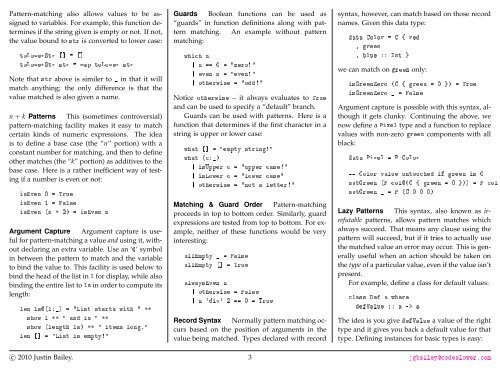You also want an ePaper? Increase the reach of your titles
YUMPU automatically turns print PDFs into web optimized ePapers that Google loves.
Pattern-matching also allows values to be assigned<br />
to variables. For example, this function determines<br />
if the string given is empty or not. If not,<br />
the value bound to ��� is converted to lower case:<br />
���������� �� � ��<br />
���������� ��� � ��� ������� ���<br />
Note that ��� above is similer to � in that it will<br />
match anything; the only difference is that the<br />
value matched is also given a name.<br />
n + k Patterns This (sometimes controversial)<br />
pattern-matching facility makes it easy to match<br />
certain kinds of numeric expressions. The idea<br />
is to define a base case (the “n” portion) with a<br />
constant number for matching, and then to define<br />
other matches (the “k” portion) as additives to the<br />
base case. Here is a rather inefficient way of testing<br />
if a number is even or not:<br />
������ � � ����<br />
������ � � �����<br />
������ �� � �� � ������ �<br />
Argument Capture Argument capture is useful<br />
for pattern-matching a value and using it, without<br />
declaring an extra variable. Use an ‘�’ symbol<br />
in between the pattern to match and the variable<br />
to bind the value to. This facility is used below to<br />
bind the head of the list in � for display, while also<br />
binding the entire list to �� in order to compute its<br />
length:<br />
��� �������� � ����� ������ ���� � ��<br />
���� � �� � ��� �� � ��<br />
���� ������� ��� �� � ����� ������<br />
��� �� � ����� �� �������<br />
Guards Boolean functions can be used as<br />
“guards” in function definitions along with pattern<br />
matching. An example without pattern<br />
matching:<br />
����� �<br />
� � �� � � �������<br />
� ���� � � �������<br />
� ��������� � ������<br />
Notice ��������� – it always evaluates to ����<br />
and can be used to specify a “default” branch.<br />
Guards can be used with patterns. Here is a<br />
function that determines if the first character in a<br />
string is upper or lower case:<br />
���� �� � ������ ��������<br />
���� �����<br />
� ������� � � ������ ������<br />
� ������� � � ������ �����<br />
� ��������� � ���� � ��������<br />
Matching & Guard Order Pattern-matching<br />
proceeds in top to bottom order. Similarly, guard<br />
expressions are tested from top to bottom. For example,<br />
neither of these functions would be very<br />
interesting:<br />
�������� � � �����<br />
�������� �� � ����<br />
���������� �<br />
� ��������� � �����<br />
� � ����� � �� � � ����<br />
Record Syntax Normally pattern matching occurs<br />
based on the position of arguments in the<br />
value being matched. Types declared with record<br />
syntax, however, can match based on those record<br />
names. Given this data type:<br />
���� ����� � � � ���<br />
� �����<br />
� ���� �� ��� �<br />
we can match on ����� only:<br />
����������� �� � ����� � � �� � ����<br />
����������� � � �����<br />
Argument capture is possible with this syntax, although<br />
it gets clunky. Continuing the above, we<br />
now define a ����� type and a function to replace<br />
values with non-zero ����� components with all<br />
black:<br />
���� ����� � � �����<br />
�� ����� ����� ��������� �� ����� �� �<br />
�������� �� ������ � ����� � � ��� � � ���<br />
�������� � � � �� � � ��<br />
Lazy Patterns This syntax, also known as irrefutable<br />
patterns, allows pattern matches which<br />
always succeed. That means any clause using the<br />
pattern will succeed, but if it tries to actually use<br />
the matched value an error may occur. This is generally<br />
useful when an action should be taken on<br />
the type of a particular value, even if the value isn’t<br />
present.<br />
For example, define a class for default values:<br />
����� ��� � �����<br />
�������� �� � �� �<br />
The idea is you give �������� a value of the right<br />
type and it gives you back a default value for that<br />
type. Defining instances for basic types is easy:<br />
c○ 2010 Justin Bailey. 3 �����������������������


